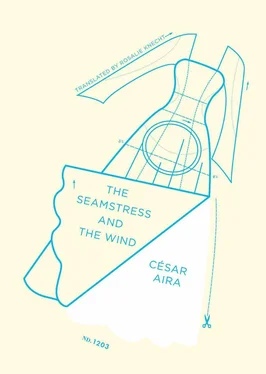All this may seem very surreal, but that’s not my fault. I realize it seems like an accumulation of absurd elements, in keeping with the surrealist method, a way of attaining a scene of pure invention without the work of inventing it. Breton and his friends brought elements together from anywhere, from the most distant places; in fact they preferred them as far flung as possible, so that the surprise would be greater, the effect more effective. It’s interesting to observe that in their search for the distant they went — for example, in the “exquisite corpses” — only to what was closest at hand: the colleague, the friend, the wife. For my part, I don’t go near or far, because I’m not looking for anything. It’s as if everything had already happened. And, in fact, it did all happen; but at the same time it’s as if it hadn’t happened, as if it were happening now. Which is to say, as if nothing had happened.
DURING THE TAXI ride Delia didn’t sew a stitch or open her mouth. She rode along stiffly in the back seat with her gaze fixed on the road, hoping against hope that she would see the truck. Zaralegui didn’t say anything either, but his silence had a different density, because it was the last afternoon of his life. He could have said his last words, but he kept them to himself. He concentrated on driving; though the traffic on the road didn’t demand much attention (there was none), the potholes did. He was a good professional. He must have been intrigued, or at least confused, by what was happening. No one had ever taken him on such an inexplicable trajectory before, and he must have been wondering how far, how long. .. He wouldn’t wonder much longer, poor man, because very soon he was going to die.
What happened was that, many hours down the road, an enormous truck suddenly hurled itself into them, into Zaralegui at the wheel, in front. Except that the truck was smashed not in front, but behind. Or rather they were the ones who hurled themselves into the truck, and at full speed, at the multiplied speed that only occurs when two vehicles collide head-on. Who knows how it could have happened, since they were both going in the same direction. Maybe the truck had reduced its speed a little, a very little, and this was equivalent to a fantastic acceleration on the part of the car coming up from behind. (To explain this episode to myself, as with so many others, I am assuming, not very realistically, enormous speeds.) What’s certain is that the Chrysler was smashed against the back of the tractor trailer in the most savage manner — was destroyed, reduced to a shell of crushed tin. And not only that: it stuck there, like a meteorite that had collided with a planet, and it continued its travels, suspended. The truck driver, ninety feet ahead, didn’t even notice. Those trucks really were like planets. Anyone driving one would never know what was happening at its unreachable extremities — especially pulling a trailer, like another planet rolling along behind.
Zaralegui died instantly; he had no time to think anything. Delia, who was riding in the back, busy attaching a bodice with her miniscule stitches, was unscathed. But the crash, the jolt, the adhesion to the planet, and Zaralegui’s backwards leap, which brought him to rest in her arms like a baby, already dead, in a rosebud of tulle, produced a considerable shock. She lost consciousness and continued the journey asleep, without seeing the landscape. It was more of an hysterical coma than sleep, and she emerged from it a different woman, gone crazy for the third time. She never knew it, but the truck driver had parked on the side of the road and slept all night in his bunk bed, the little compartment those trucks have behind the cab, and then resumed the trip at dawn and didn’t stop the whole next day.
When Delia awoke, the sun was setting over the province of Santa Cruz.
PATAGONIA. . the end of the world. . yes, agreed; but the end of the world is still the world. The whole pink sky, like the petal of a colossal flower, the blue earth, an immobile disk with no other end but the horizon. . That was the world, then. That was the whole world, that place where Delia had been taken by accident, by the mad force of events, and from which it seemed entirely unthinkable that she would ever escape. At first she felt like a child on a carousel, riding on the back of a beetle made of black glass. She even thought she heard music; and she did, actually, but it was the whistling of the wind.
Then, all at once, the horrible circumstances of which she was victim and protagonist became clear to her. She let out a scream and waved her arms in terror, at which Zaralegui’s corpse abandoned her lap and flew out of the car. A pothole must have helped: she wasn’t that strong.
And in addition to the potholes, in all certainty, the maelstrom of wind — at full speed the truck displaced a mass of air the volume and weight of a mountain. The mountains missing from that infinite plateau were created by the air. But there was also wind, and more than a little: Patagonia is the land of wind. In fact there were various winds, which competed for the dust raised by the truck and fought fiercely with the vehicle’s own wind, packed and wrapped by speed. They unwrapped this package a thousand times a second with a sound like paper in the air, they untied the ribbons of gravity, they tore up in their hurry, like children driven by the sight of toys, both its rigid and fluid folds.
Zaralegui gave two half-somersaults twelve feet in the air; no acrobat in the world could have imitated his pirouettes with the broken spine that he had. Then he went flying off to one side. Since his arms were moving, agitated by the same force that carried him, he seemed alive. What a spectacle! But the conjunction of the pothole and the whirlwind must have made a catapult, because Zaralegui wasn’t the only one who flew: he was followed by the dress, Delia, and the car, in that order. When the dress opened the enormous white wings of its train and rose, at a supersonic velocity, up and away, Delia felt dispossessed. It was her work that was going, and she was left out, useless. She thought she’d never get it back. And then when Delia herself took flight, all her feelings contracted into terror. It was the first time she flew.
The earth dropped away, the truck too — (the last she saw of it was the back wall of the trailer, from which the black cocoon that had been the Chrysler was coming loose, to take its turn at flying) — the sky approached vertiginously. She closed her eyes and after an instant opened them again.
The sun, which had already set on the surface, appeared again at the end of the world; it was the first time she’d seen the sun after it had set. It was as red as a red rubber ball slick with luminous oil. And it was in a strange place: although visible, it stayed below the line of the horizon, in a niche. It was the nighttime sun, which no one had ever seen.
And it’s not as if Delia lingered in contemplation of the sun. It couldn’t even be said that she looked at it. She wasn’t even thinking, and thinking always comes before looking. Flying was an absorbing activity for her — so much so, and so absorbing of life, that she was absolutely convinced she would not survive. And how could she? The contradictory currents of the wind had carried her, in two or three somersaults, to a height of more than a hundred yards. The circle of the horizon changed position as if the compass had fallen into the hands of a lunatic. The winds seemed to be shouting berserkly: “You take her!. . Give her here!” — amid uncanny bursts of laughter. Delia was thrown back and forth, vibrating, vibrating, like a heart in the heights and depths of love, or in space.
“These are my last moments,” she screamed to herself without moving her lips. The last seconds of her life, and afterward there would be only the black night of death. . Her anguish was unspeakable. Talking in terms of seconds was rhetoric, but it was also a great truth. The mad winds seemed bold enough to turn the seconds into minutes, and even hours, and if they felt like it, it would not be out of place to say days. But even so they would be seconds, because anguish compresses time, whatever interval of time, to the painful dimensions of seconds.
Читать дальше












